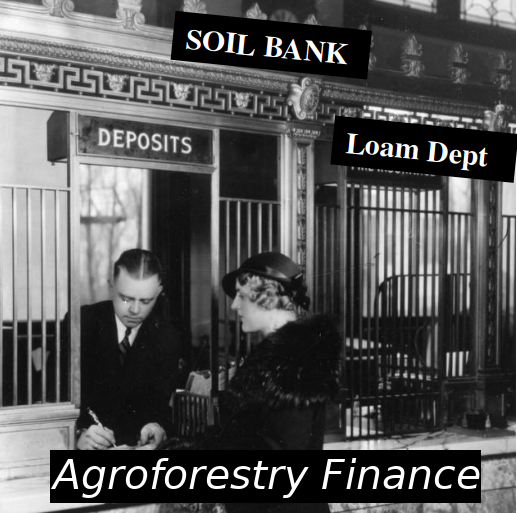Getting Started in Agroforestry: Part 3, Finance
by George Powell
Options for agroforestry finance don’t differ greatly from those for other agricultural ventures. But, after you select a target market and outline a marketing strategy, finance is your next most important consideration. And you should have a financial plan in mind before making production decisions.
If you are one of those lucky few for which money is no object, this article is not for you. For the rest of us, money always has some importance in our decisions, and you should read on.
Agroforestry Finance Options

How much up-front finance you will need, and where you source it from, will determine if you can get your agroforestry venture off the ground. Or in the ground? Unless you are using it purely for conservation goals, agroforestry operations always involve a perennial tree or shrub crop. Therefore, you must secure patient capital. The options being:
- Self funding (using your own savings, the bank of Mom and Dad, or spending your kids’ inheritance);
- Setting up a corporation or partnership, and selling shares (solid business plan/prospectus and some good luck required);
- Obtaining a term loan or line of credit (bullet-proof business plan and even better luck required).
Most will self-fund their start-up. And your patience may be stretched thinner than your bank account early in your agroforestry adventure. If you have off-farm income it can help. And follow the same advice given to aspiring actors: don’t quit your day job. At least not until the cash flows back towards you.
Some investments can be defrayed by grants or support programs. Unfortunately, agroforestry support funding is few and far between for most areas. Particularly those aimed at increasing tree planting for other than conservation purposes.
Cash Flow Needs
Christmas trees, ornamentals, berry and fruit crops may require 5 to 7 years from planting until first harvest. Fast growing forest trees for pulp wood or chips can take 20 to 30 years to mature. And veneer and even some lumber species can take 80 to 100 years before harvest is considered.
This puts most long-term perennial crops in a precarious economic position. Because investments made early for planting and stand tending may not see a direct return until many years later. All the while inflation eats away at your returns.
This however, is where agroforestry shines. By generating short-term cash flows from blending annual crops, livestock, etc. with the long-term investment in woody perennials. The short-term cash returns generated annually, offset the discounting for your long-term investment. This makes the whole venture more viable.
This also means, even in an agroforestry setting, you will have better returns if you don’t start from a bare field. The option to work from modifying existing tree and shrub resources is always more profitable than establishing a new planting. But that presumes your existing trees and shrubs can meet your operational goals.
Utilizing Other Resources
For existing agricultural or woodlot ventures, not all of your agroforestry finance needs may be required from outside sources. Some costs may be offset or negated by your existing resources. That is, equipment, skilled labour and facilities that are not in full use.
Making better year-round use of existing resources reduces your overall investment requirements. And, it is also another strength of agroforestry, as an integrated production option relative to conventional agriculture and forestry.
Diversify, Don’t Diworseify
A note of caution about using agroforestry to diversify your existing production: diversify, don’t diworseify.
One of the many strengths of agroforestry is that the work loads for the ‘agro’ and ‘forestry’ components can often be complementary. That is, the peak demands for production tasks, management and marketing can fall at different times of the year.
This blending of components gives you a leg up for smart diversification. You can bring on new production, with an additional revenue source and conservation benefits. All without any unplanned impairments to your existing business.
Without some forethought and planning, however, the opposite can occur. You will ‘diworseify your operation when the time and resources you need to devote to your new agroforestry venture, eats into production and/or profitability of your core business.
Onward to Production
With market and financing considerations now in you plan, it’s time to consider your production setting. And also look at how your production goals, markets and financial resources will shape the design of your agroforestry venture.
Subscribe via RSS
